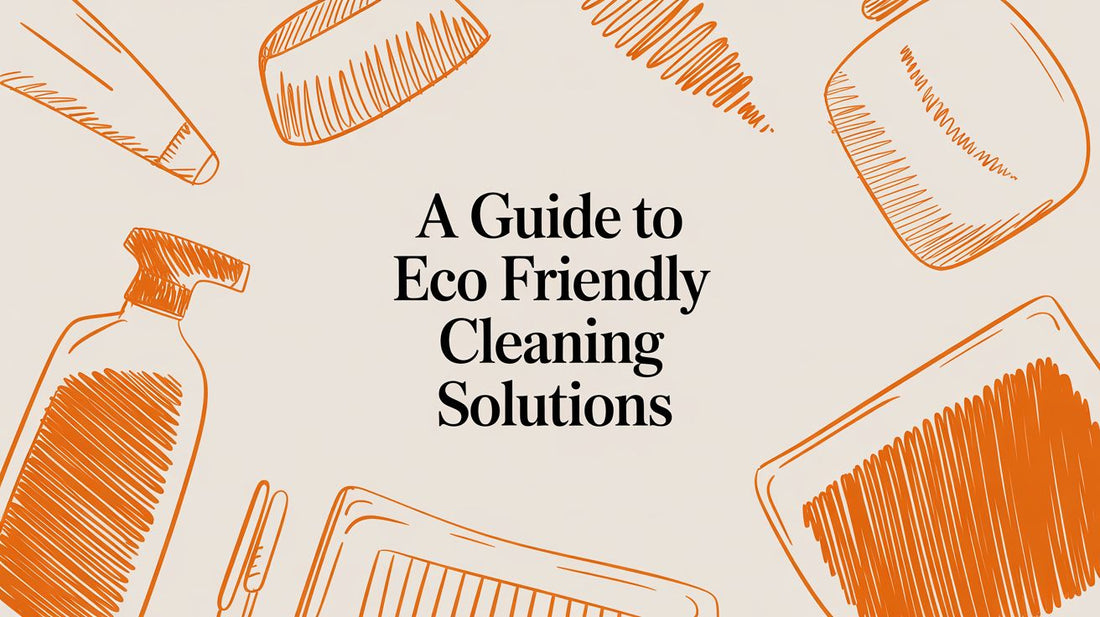
A Guide to Eco Friendly Cleaning Solutions
Share
Chances are, you’ve opened a window to “air out” the house after a cleaning session. We all know that harsh chemical smell. It’s a sign that the very products we use to make our homes feel clean might actually be doing more harm than good.
This is exactly why so many people are making the switch from old-school, synthetic cleaners to safer, more sustainable options.
Why Everyone Is Talking About Green Cleaning
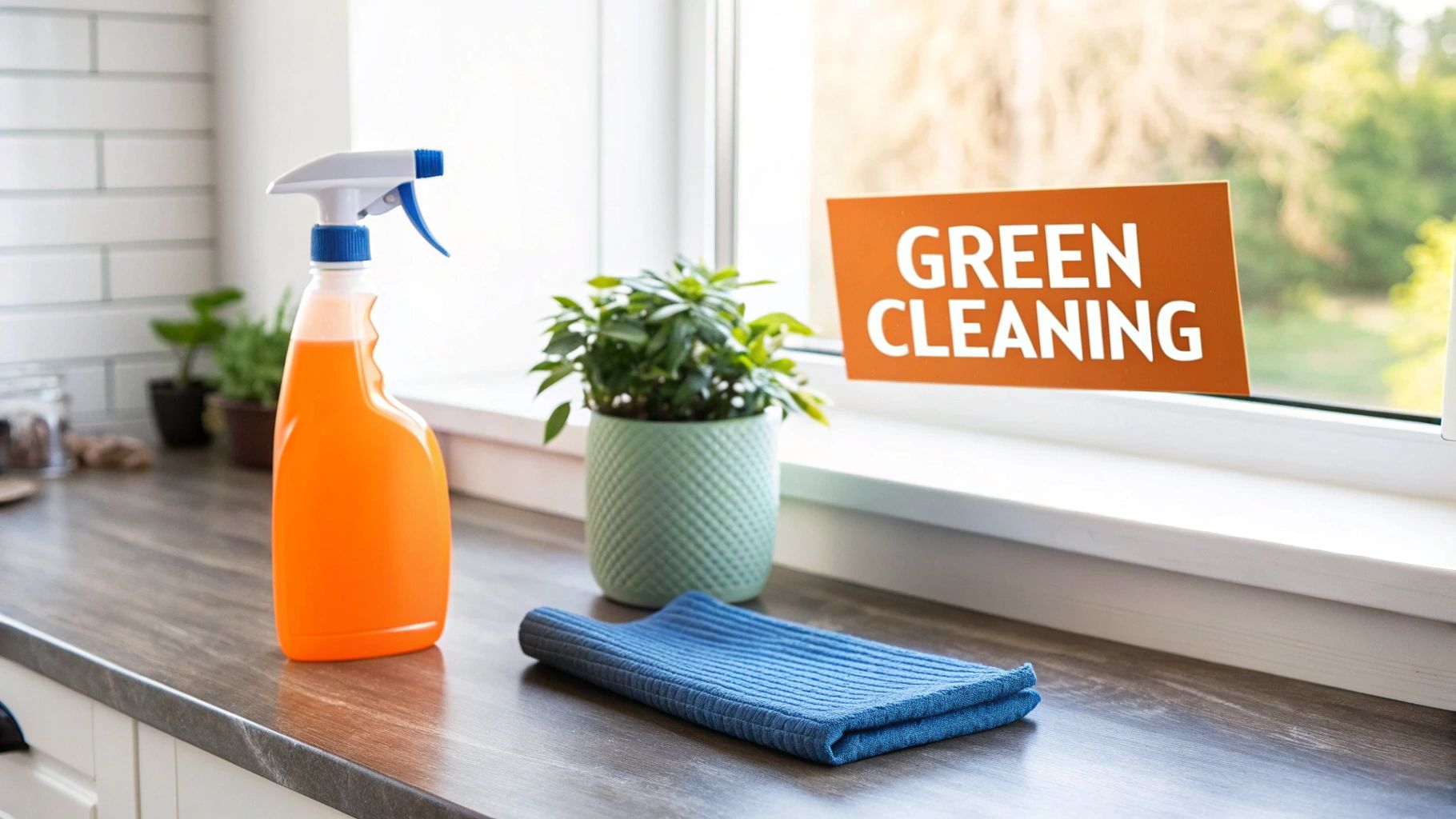
The idea of eco-friendly cleaning solutions is about much more than just using "natural" ingredients. It’s a bigger commitment to a healthier way of living that looks at the entire journey of a product, from how it’s made to what happens when you’re done with it.
This isn’t some fringe movement anymore. It reflects a growing desire for living spaces that are truly safe and a planet that isn’t paying the price for our clean countertops.
Decoding Green Cleaning
So, what does "green" or "eco-friendly" really mean when it comes to a cleaning product? It boils down to a few core principles that set them apart from the chemical-heavy jugs on most store shelves. Once you know what to look for, it’s much easier to see past the marketing hype.
Genuine eco-friendly cleaners share these key traits:
- Non-Toxic Ingredients: They are made without harsh chemicals like ammonia, chlorine, or phthalates, which are known culprits for causing respiratory issues and other health problems.
- Biodegradability: Their ingredients break down naturally. This means they won’t build up in our water systems or harm aquatic life after they go down the drain.
- Ethical Sourcing and Production: The raw materials are sourced responsibly, and the manufacturing process is designed to minimize waste, water, and energy use.
- Sustainable Packaging: Forward-thinking companies use recycled materials, offer convenient refillable bottles, or create concentrated formulas to slash plastic waste.
The move toward eco-friendly cleaning solutions is a clear indicator of a broader change in consumer values. People are actively seeking products that align with their health and environmental ethics, demanding transparency and accountability from brands.
This isn't just a feeling; the numbers back it up. In 2023, the global market for green cleaners hit about $25 billion. It’s expected to shoot up to $45 billion by 2032. This incredible growth is driven by smart consumers who know that a clean home shouldn't come at the cost of their family's health or the planet's. You can dig into more data on these eco-friendly cleaner market trends over on Dataintelo.com.
How Nature-Inspired Cleaners Actually Work
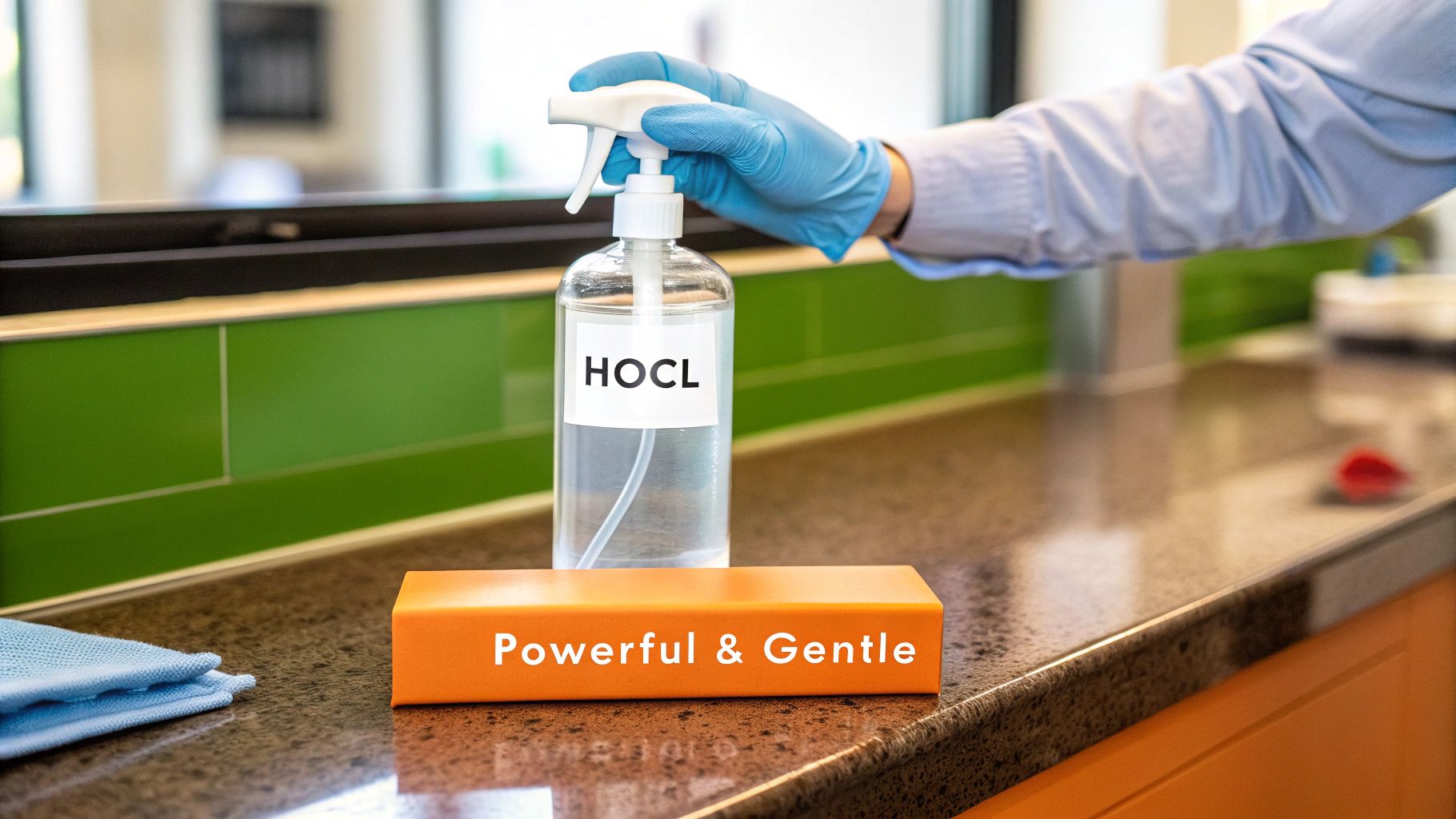
Most of us grew up thinking that for a cleaner to work, it had to be harsh. We've been conditioned to associate the strong, chemical smell of bleach with a job well done. But what if the most powerful cleaning solutions weren't harsh at all? What if they were inspired by nature itself?
Instead of relying on brute-force chemicals, some of the best eco-friendly cleaners mimic biological processes that have been perfected over millions of years. This approach delivers incredible cleaning and disinfecting power without the scary side effects, proving you don't have to choose between 'natural' and 'effective'.
The Body's Own Disinfectant
One of the most amazing examples of this is hypochlorous acid, or HOCl. The name might sound like something out of a chemistry lab, but the concept is actually something you experience every single day. It’s the very same substance your own white blood cells produce to fight off infections and kill germs.
Think of it as your body's personal, built-in cleaning crew. When a virus or bacteria gets into your system, your immune response creates HOCl to neutralize the threat. It’s devastatingly effective at its job, yet perfectly safe for your body.
Eco-friendly cleaning solutions that use HOCl have essentially figured out how to harness this natural defense mechanism and put it in a bottle. Now you can clean your home with the same gentle but powerful agent that protects you from the inside out.
The screenshot below from Wikipedia shows the simple chemical structure of hypochlorous acid (HOCl).

What you’re seeing is a molecule made of just hydrogen, oxygen, and chlorine—the basic elements found in salt and water. This simple structure is the secret to its power and safety, allowing it to wipe out germs before harmlessly breaking down.
By mimicking the human immune system, HOCl-based cleaners provide a powerful disinfecting action that is tough on pathogens but gentle on people, pets, and the planet. It’s a perfect example of science learning from nature’s wisdom.
When you spray an HOCl solution on a surface, it gets to work immediately, eliminating bacteria and viruses. But here's the best part: once its job is done, it simply breaks down into a mild saline solution—salt and water. No toxic residues left behind, no harsh fumes to breathe, and no lasting damage to the environment.
How HOCl Measures Up
You might be wondering if something this gentle can really hold its own against traditional chemical cleaners. The answer is a big, loud yes. HOCl is a potent disinfectant that can neutralize a huge range of common household pathogens.
Here’s a quick look at how it works:
- Oxidization: HOCl works by oxidizing the cell walls of microbes like bacteria and viruses, causing them to burst and die. It's a direct and effective takedown.
- Speed: This process happens almost instantly, neutralizing germs on contact or within just a few seconds.
- Safety: Unlike bleach, it doesn't release harsh fumes or require you to wear gloves for everyday cleaning tasks.
This unique mix of strength and safety makes it the perfect all-purpose cleaner. To get a better idea of just how versatile it is, you can explore the many hypochlorous acid spray uses that make daily cleaning so much simpler.
Beyond HOCl: Plant-Based Powerhouses
Of course, HOCl isn't the only hero in the world of eco-friendly cleaning. Many other great products get their power from plant-derived ingredients that people have trusted for centuries. These work through different, but equally effective, mechanisms.
Citric acid, for example, is a master at breaking down hard water stains and soap scum. Derived from citrus fruits, its acidic nature dissolves mineral deposits without the risk of damaging surfaces like stone or marble, which can be harmed by stronger acids.
Essential oils from plants like tea tree, lemon, and eucalyptus do more than just add a fresh, natural scent. Many have their own antimicrobial properties, adding another layer of cleaning power while deodorizing your space without artificial fragrances. The best plant-based cleaners use a smart blend of these ingredients, where each one enhances the effectiveness of the others to create a powerful, safe formula.
The Real Benefits for Your Home and Health
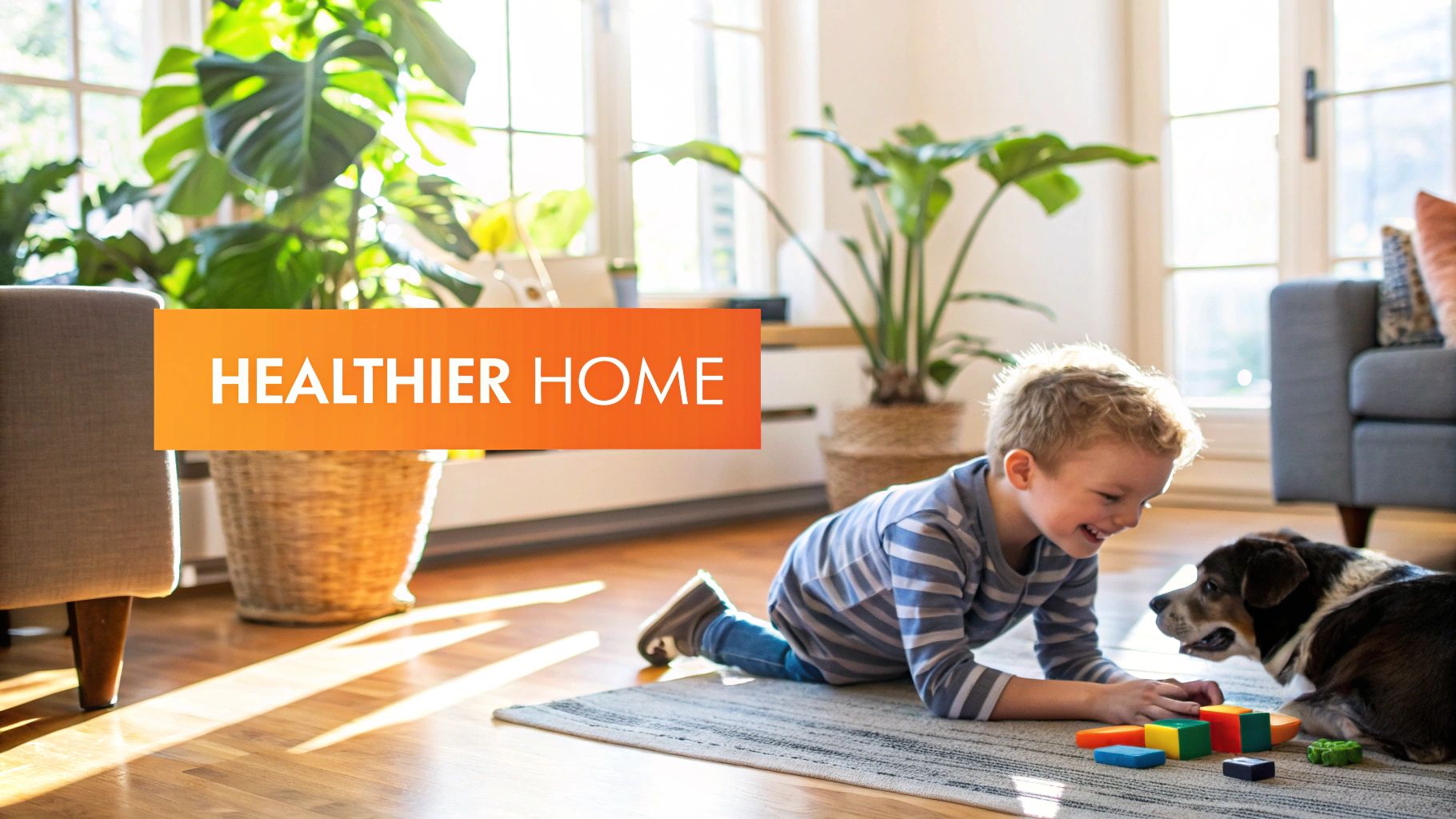
Choosing an eco friendly cleaning solution is so much more than a trend—it's a direct investment in the health of your home and the people (and pets) who live there. The benefits aren't abstract; they're immediate and tangible, starting with the very air you breathe.
When you make the switch, you’re doing more than just wiping down surfaces. You’re actively creating a healthier, safer environment. This shift delivers rewards you can see, feel, and even smell (or rather, not smell), turning your home into a space that genuinely supports well-being.
Breathe Easier with Better Indoor Air
One of the first things you'll notice is a dramatic improvement in your home's air quality. That powerful, sharp "clean" scent you get from traditional cleaners like bleach or ammonia? That's actually a cloud of volatile organic compounds (VOCs).
VOCs are chemicals that easily turn into gases at room temperature. They can linger in the air long after you’ve capped the bottle, contributing to headaches, dizziness, and respiratory irritation. In fact, studies show that using conventional spray cleaners can expose you to indoor pollutant levels on par with a heavily polluted city.
By simply eliminating cleaners that off-gas harsh chemicals, you immediately lower the chemical load in your home's atmosphere. This creates a safer breathing space for everyone, especially kids, the elderly, and anyone with asthma or allergies.
Eco friendly alternatives, especially those that are fragrance-free or use natural scents, get the job done without flooding your home with these aggressive chemicals. The result is a home that’s truly clean, right down to the air you breathe.
A Safer Space for Family and Pets
Beyond the air, the actual surfaces in your home become safer. Traditional cleaners can leave behind a thin film of chemical residue on countertops, floors, and furniture. This residue can be absorbed through the skin or accidentally ingested, which is a huge concern in homes with curious kids and pets.
Think about it: toddlers explore the world with their hands and mouths, and pets are constantly grooming their paws after walking across the floors. Using non-toxic, biodegradable cleaners means you don't have to second-guess their safety.
- For Kids: You get peace of mind knowing the high chair tray or the playroom floor is free from corrosive chemical residue.
- For Pets: Their paws, fur, and sensitive noses are protected from harsh irritants that can cause nasty skin reactions or internal issues.
This growing awareness is driving massive change. The global natural household cleaners market was valued at USD 6.56 billion in 2024 and is projected to hit USD 18.04 billion by 2033. That's not just a trend; it's a movement. You can dive deeper into the market projections on Grand View Research.
The Broader Environmental Impact
The positive effects of choosing eco friendly cleaners extend far beyond your front door. What you pour down the drain matters.
When you use conventional chemical cleaners, those harsh ingredients wash into our waterways. Many of these substances, like phosphates, aren't easily broken down by water treatment plants. They can build up in rivers and lakes, harming fish and disrupting fragile ecosystems.
On top of that, there's the plastic problem. Most traditional cleaners come in single-use plastic bottles, creating a mountain of waste that chokes landfills and oceans.
To give you a clearer picture, let’s compare the two side-by-side.
Comparing Traditional vs Eco Friendly Cleaners
This table highlights the key differences in impact between traditional chemical cleaners and modern eco friendly solutions.
| Feature | Traditional Cleaners | Eco Friendly Solutions |
|---|---|---|
| Indoor Air Quality | Releases VOCs, can cause respiratory irritation | No harsh fumes, improves air quality |
| Residue Safety | Leaves behind potentially harmful chemical residue | Non-toxic, safe for contact with kids and pets |
| Environmental Impact | Pollutes waterways, ingredients harm aquatic life | Biodegradable, breaks down into harmless components |
| Packaging | Primarily single-use plastic, contributes to waste | Often uses refillable, recycled, or minimal packaging |
As you can see, the choice is pretty clear. Eco-conscious brands are tackling the waste issue head-on with sustainable packaging like refillable containers and concentrated formulas, which drastically cut down on plastic use over time.
By making this simple switch, you're not just cleaning your home—you're participating in a circular economy that values resources, protects our environment, and keeps our families safe.
How to Choose Products That Truly Deliver
Walking down the cleaning aisle can feel like a pop quiz you didn't study for. With so many bottles shouting "green," "natural," and "sustainable," how can you tell which ones are the real deal? It’s simpler than you think. The secret is to look past the flashy marketing on the front and become a savvy label reader.
Making the right choice isn't just about buying another cleaner. It's an investment in a healthier home for your family and a lighter footprint on the planet. Once you know what to look for, you can confidently pick products that are both powerful and safe—getting the results you want without any of the nasty side effects.
Look for Legitimate Certifications
The easiest way to cut through the noise is to look for third-party certifications. These logos are like a seal of approval from trusted, independent organizations that have put the product through rigorous testing against strict health and environmental standards. Think of them as a reliable shortcut to finding genuinely green products.
When you're scanning the shelves, keep an eye out for these well-respected symbols:
- EPA Safer Choice: This label from the U.S. Environmental Protection Agency means every single ingredient has been reviewed for its impact on human health and the environment. It's a guarantee that the product uses safer ingredients without sacrificing performance.
- ECOLOGO: This certification takes a whole-picture approach, looking at a product's entire life cycle—from the raw materials and manufacturing to its packaging and disposal—to ensure it has a reduced environmental impact.
- Green Seal: Similar to ECOLOGO, this non-profit certification confirms that a product meets high standards for performance, health, and sustainability. It's another trusted mark that helps you steer clear of "greenwashing"—that sneaky marketing tactic where companies make environmental claims they can't back up.
These certifications do all the hard work for you, giving you peace of mind that what you’re buying is a genuinely better choice.
Mastering the Art of Label Reading
Beyond certifications, the ingredient list is your best friend. Truly eco friendly cleaning solutions are transparent about what’s inside. If you see vague terms like "all-natural" or "plant-derived" without a list of specific ingredients, it's a red flag.
Look for products with clear, simple, and recognizable ingredients. You'll want to avoid anything containing harsh chemicals like:
- Ammonia
- Chlorine bleach
- Phthalates
- Parabens
- Artificial fragrances
A truly eco-friendly brand wants you to know what's in their bottle. Transparency is a hallmark of trust, so prioritize products that provide a full, easy-to-understand ingredient list over those that hide behind generic marketing terms.
Getting into the habit of flipping the bottle over is a simple act that empowers you to make choices that truly align with your values.
Amplify Your Cleaning with the Right Tools
Making the switch to eco-friendly cleaners is a fantastic step, but pairing them with the right tools can take your cleaning from good to great. You don’t need a closet full of complicated gadgets; a few simple, reusable items are all it takes to boost the power of your green cleaners and cut down on waste even more.
The most valuable player in your eco-friendly cleaning kit is the microfiber cloth. These aren't your average rags. Their ultra-fine fibers create a natural static charge that attracts and traps dust, dirt, and germs far more effectively than old cotton towels or disposable paper.
Using microfiber often means you need less cleaning solution to get the job done, which saves you money and product over time. Better yet, they can be washed and reused hundreds of times, making them an incredible sustainable alternative to single-use wipes and paper towels. A small investment in a quality set of microfiber cloths will pay for itself many times over, both for your wallet and the planet.
Putting Green Cleaning to Work Everywhere
The benefits of green cleaning don’t just stop at your front door. These powerful, non-toxic solutions are making their way into all the places we live, work, and play, creating healthier environments for everyone from office workers to young children.
This isn’t some niche trend, either. It’s quickly becoming the new standard for public health. As more organizations realize their responsibility to protect both people and the planet, green cleaning is becoming a non-negotiable part of daily operations.
Creating Healthier Workplaces
We’ve all experienced it: that stuffy, recycled office air, often thick with the smell of harsh cleaning chemicals. The fumes from conventional cleaners can linger for hours, contributing to poor indoor air quality that’s been linked to headaches, fatigue, and a general feeling of being unwell—often called "sick building syndrome."
By making the switch to eco friendly cleaning solutions, businesses are making a direct investment in their team's well-being. Using fume-free, non-toxic products cuts out a major source of indoor air pollution. It creates a workspace where people can breathe easier, focus better, and feel healthier.
This infographic breaks down the key things to look for when choosing the right eco-friendly cleaners for any space, from certifications to ingredients and packaging.
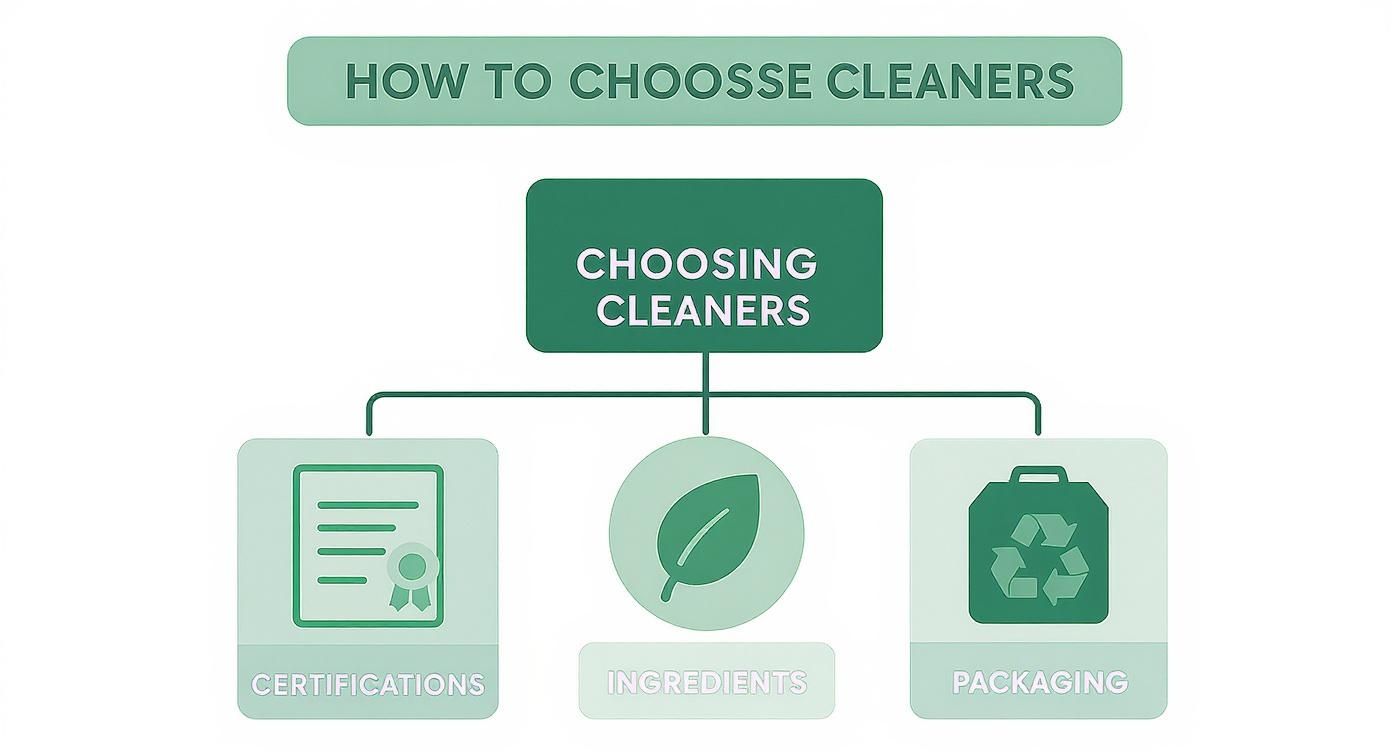
As you can see, a truly sustainable choice means looking at the entire lifecycle of a product—from how it’s made to how it's disposed of.
Safe Sanctuaries in Schools and Gyms
The places we dedicate to health and learning should be the safest of all. Yet, schools and fitness centers have historically relied on some of the most aggressive disinfectants out there to tackle germs on high-touch surfaces.
- In Schools: Kids are especially vulnerable to the effects of harsh chemical residues. Green cleaning protects them from exposure on desks, toys, and lunch tables, creating a genuinely safe place to learn and play.
- In Gyms: Fitness equipment is a known hotspot for bacteria. But dousing it in harsh chemicals often leaves behind a sticky residue that can irritate the skin. Eco-friendly disinfectants knock out germs effectively without leaving a corrosive film, keeping equipment clean and safe for everyone.
This shift in consumer and business demand is fueling major market growth. The global market for eco-friendly cleaning products is expected to jump from USD 13.2 billion in 2025 to USD 31.1 billion by 2034. This growth is largely driven by major companies expanding their green product lines, as detailed in the full market analysis on gminsights.com.
The Ultimate Choice for Pet Owners
When you have pets, the word "safe" takes on a whole new level of importance. Our furry family members are constantly rolling on floors, sleeping on furniture, and grooming themselves, meaning they can easily ingest any chemical residues left behind.
Choosing a pet-safe cleaner isn't a luxury; it's a necessity. Eco-friendly formulas, especially those like HOCl that break down into simple saline, eliminate the risk of accidental poisoning and skin irritation, giving pet owners true peace of mind.
These cleaners are tough on pet messes—from muddy paws to unexpected accidents—but gentle enough to use on their beds, bowls, and toys. They neutralize odors at the source instead of just covering them up with artificial fragrances that can overwhelm a pet’s sensitive nose. For a closer look at how these cleaners can simplify a busy household, check out our guide on how versatile all-natural HOCl cleaners fit every lifestyle.
From bustling corporate offices to cozy living rooms shared with pets, eco-friendly cleaning solutions have a place everywhere. They offer a powerful, reliable way to keep things clean and hygienic without compromising on health or our responsibility to the planet. This widespread adoption proves one simple thing: a truly clean space is one that’s safe for every single person—and pet—in it.
Here is the rewritten section, crafted to sound like an experienced human expert in line with the provided examples.
Smarter Ways to Buy and Use Cleaners
Making the switch to green cleaning is about more than just what's in the bottle—it's about changing how we think about cleaning altogether. For decades, we've been stuck in a cycle of buying bulky, single-use plastic bottles, using them up, and tossing them out. This doesn’t just clog up our landfills; it drains our wallets, too.
There's a much better way, and it starts with prioritizing concentrated formulas and refill systems. When you buy a typical cleaner off the shelf, you're mostly paying for water and a plastic bottle destined for the trash. That model creates a staggering amount of waste and burns a lot of fuel shipping heavy, water-filled containers around the country.
Concentrates change the game completely. You get a small, powerful formula and just add your own water at home. It’s a simple shift with a huge impact.
The Power of Refills and Concentrates
Moving to a refill model isn't just a feel-good choice; it offers real, tangible benefits for both the planet and your budget. It’s a straightforward approach that cuts right to the heart of the waste problem in the cleaning aisle.
Here’s how it makes a real difference:
- Drastically Reduces Plastic Waste: Think about it: one small bottle of concentrate can replace a whole lineup of full-sized spray bottles. That’s a lot of plastic that never even gets made, let alone thrown away.
- Lowers Your Carbon Footprint: Shipping lightweight concentrates takes far less fuel than hauling heavy, water-based cleaners. This directly cuts down on transportation emissions and the overall environmental cost of getting products to your door.
- Saves Money Over Time: Sure, the first purchase might include a reusable spray bottle, but the refills are where you really save. You stop paying for packaging and water every single time, and those savings add up fast.
When you choose concentrates, you’re doing more than just cleaning. You're becoming part of a circular system—one designed to cut waste, save resources, and build a more sustainable future.
Smart Purchasing for Homes and Businesses
This smarter way of buying is for everyone, from families trying to be a little greener to large businesses aiming for big sustainability wins. For your home, grabbing a one-gallon refill jug of an all-purpose eco friendly cleaning solution can last for months. It simplifies your shopping list and clears out that clutter under the sink.
For businesses, schools, or gyms, the argument is even more compelling. Buying in bulk or setting up a wholesale account dramatically lowers the per-unit cost while helping you meet your sustainability goals. It’s a smart business move that shows you care about the health of your people and the planet.
Ultimately, opting for refills isn't just about buying a cleaner. It's a vote for a more efficient, less wasteful system that benefits all of us.
Common Questions About Eco-Friendly Cleaners
Making a switch always brings up a few questions, and moving to eco-friendly cleaning solutions is no different. It’s smart to be a little skeptical and ask the tough questions before you change up your whole routine. Let's tackle some of the most common hesitations head-on, so you can feel confident you're making a better, healthier choice.
One of the biggest hang-ups people have is whether a "natural" cleaner can really be as powerful as something like bleach. This idea comes from an old myth that harshness equals effectiveness. But the science behind advanced disinfectants like hypochlorous acid (HOCl) proves you can have incredible strength without the toxicity.
HOCl is a nature-inspired powerhouse that wipes out germs just as effectively as traditional chemicals, but it’s gentle enough for everyday use around your family. If you want to dive deeper, you can learn about the key differences between sanitizing and cleaning to see how it all works.
Are They More Expensive?
Another question that comes up a lot is cost. While some green products might look a bit pricier on the shelf, it’s important to look at the bigger picture and the real value you're getting. True savings often come from the smarter purchasing habits that eco-conscious brands encourage.
- Concentrated Formulas: You buy a small amount of potent cleaner and just add your own water at home. This means you aren't paying for plastic and shipping water with every single purchase.
- Refill Systems: Investing in one good reusable spray bottle and buying larger refill jugs dramatically lowers your cost per ounce over time. It just makes sense.
Investing in your health and a cleaner environment is the ultimate long-term value. By avoiding harsh chemicals, you reduce potential health risks, and by choosing refills, you actively cut down on plastic waste—making it a win for both your wallet and the planet.
How to Avoid Greenwashing
With so many products slapping a "green" label on the bottle, how can you spot the fakes? "Greenwashing" is just a marketing trick where companies make misleading claims about how environmentally friendly they are. To avoid getting fooled, you have to become a savvy label reader.
Look for transparency and proof. A genuinely eco-friendly brand will be open about its ingredients and won't be afraid to back up its claims.
What to look for:
- Third-Party Certifications: Keep an eye out for seals from trusted organizations like EPA Safer Choice or ECOLOGO. These logos are proof that a product has met strict health and environmental standards.
- Clear Ingredient Lists: Vague terms like "plant-based" aren't enough. A trustworthy brand will tell you exactly what’s in the bottle, using names you can actually understand.
By focusing on verified certifications and straightforward ingredient lists, you can confidently pick products that truly deliver on their promise to be safe, sustainable, and effective.
Ready to experience a powerful, transparent, and genuinely eco-friendly clean? Discover the science-backed solutions from OrbitEnviro and see how simple it is to keep your spaces safe for everyone. Explore our products at https://www.orbitenviro.com.
Article created using Outrank
